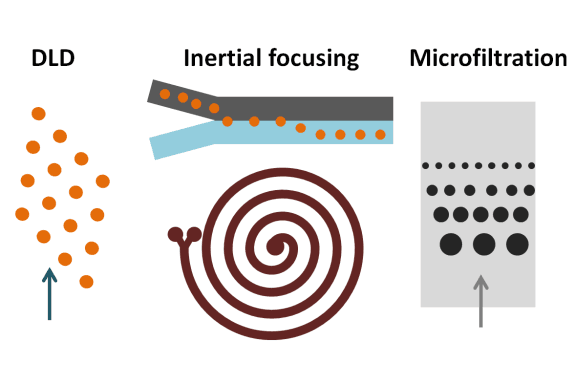Active microfluidic cell sorting employs an external source such as acoustic, magnetic, or electric for cell sorting
Active methods are developed to increase the efficiency and accuracy as well as the specificity of microfluidics cell sorters at the expense of using an external power field. The modularity and versatility of microfluidic chips allow various external sources to be integrated with the chips. Acoustic, magnetic, and dielectric forces are among the ones that are vastly used in microfluidic cell sorters.
Acoustophoresis
 Like all other active methods, acoustophoresis requires an external source for cell sorting. Here, the external source comes from acoustic waves. These microfluidic devices mostly use interdigital transducers (IDTs) embedded underneath the microchannels. These IDTs generate acoustic waves known as Standing Surface Acoustic Waves (SSAW). Acoustic waves are able to create pressure nodes along the microchannels. These pressure nodes can cause cells to move to specific regions of the channel. Continuous exposure of the cells to these acoustic waves leads to cell sorting based on their characteristics. The force that the cells experience due to the waves is dependent on the size. Thus, cells with different sizes experience different forces and transfer to a different location. Microfluidic chips can be fabricated to employ acoustic force for cell sorting could be stacked to achieve multi-level cell sorting. In the first step, large cells and smaller cells could be roughly separated. The criteria for the separation in the microfluidic chips can get finer and finer in the next chips to achieve high cell separation and cell sorting resolutions. This method has helped in developing multi-step acoustophoretic microfluidic chips for isolation of submicron extracellular vesicles, such as exosomes, from blood samples.
Like all other active methods, acoustophoresis requires an external source for cell sorting. Here, the external source comes from acoustic waves. These microfluidic devices mostly use interdigital transducers (IDTs) embedded underneath the microchannels. These IDTs generate acoustic waves known as Standing Surface Acoustic Waves (SSAW). Acoustic waves are able to create pressure nodes along the microchannels. These pressure nodes can cause cells to move to specific regions of the channel. Continuous exposure of the cells to these acoustic waves leads to cell sorting based on their characteristics. The force that the cells experience due to the waves is dependent on the size. Thus, cells with different sizes experience different forces and transfer to a different location. Microfluidic chips can be fabricated to employ acoustic force for cell sorting could be stacked to achieve multi-level cell sorting. In the first step, large cells and smaller cells could be roughly separated. The criteria for the separation in the microfluidic chips can get finer and finer in the next chips to achieve high cell separation and cell sorting resolutions. This method has helped in developing multi-step acoustophoretic microfluidic chips for isolation of submicron extracellular vesicles, such as exosomes, from blood samples.
Magnetophoresis
Magnetophoresis, as the name implies, requires a magnetic force to sort the cells. Here, we need a permanent magnet along with magnetic cells for cell sorting.
Cells are not intrinsically magnetic. Therefore, they need to be rendered magnetic using standard immunomagnetic methods. The cells should be labelled first and then attached to magnetic beads. The magnet positioned near the channel exerts a magnetic force on the labelled cells. The force depends on the cell size. Thus, the larger cells lie closer to the wall than the smaller cells.
 Magnetophoretic microfluidic chips for cell sorting and separation are well-known for their speed and simplicity. Moreover, compared to other active cell sorters, these chips are cost-effective and easier to fabricate; the permanent magnets are cheap and it is straightforward to embed them in microfluidic chips. However, it should be noted that detaching the cells from the magnetic beads can be difficult. Thus, if you plan to manipulate the cells after sorting, another active or passive cell sorting microchip would be a better choice.
Magnetophoretic microfluidic chips for cell sorting and separation are well-known for their speed and simplicity. Moreover, compared to other active cell sorters, these chips are cost-effective and easier to fabricate; the permanent magnets are cheap and it is straightforward to embed them in microfluidic chips. However, it should be noted that detaching the cells from the magnetic beads can be difficult. Thus, if you plan to manipulate the cells after sorting, another active or passive cell sorting microchip would be a better choice.
Dielectrophoresis
Dielectrophoresis refers to the movement of dielectric cells/particles in a non-uniform electrical field. Therefore, for dielectrophoresis, two things are required: A polarizable cell/particle and a non-uniform electrical field. Dielectrophoresis does not need the cells to be charged. In a uniform field, cells do not experience any forces. But, in a non-uniform field, the polarization of the cells leads to a positive or negative force. The size and direction of this force depend on the particles’ electric properties and the electric field. Cells have different dielectric properties thus respond differently to the non-uniform electric field. This difference is employed in dielectrophoretic microfluidic chips for sorting and separating the cells. The electric field can be adjusted based on the type and shape of the electrodes. For more information on different types of electrodes in microfluidic chips, please check the resources section below. The possibility of applying both negative and positive forces along with being label-free is the advantage of these microfluidic chips.
Further Reading
Acoustophoresis
- Acoustofluidic separation of cells and particles
- Rapid and effective enrichment of mononuclear cells from blood using acoustophoresis
- Improved Understanding of Acoustophoresis and Development of an Acoustofluidic Device for Blood Plasma Separation
- Isolation of exosomes from whole blood by integrating acoustics and microfluidics
Magnetophoresis
Dielectrophoresis
Learn more about the passive microfluidic cell sorting techniques such as inertial focusing, DLD, and microfiltration



